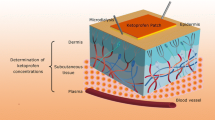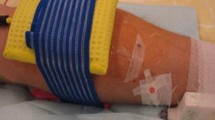Abstract
Purpose. The primary objective of this study was to determine the rate and extent of transdermal absorption for systemic delivery of diclofenac from Pennsaid (Dimethaid Research, Inc.) topical lotion into the systemic circulation after the lotion was applied to human volunteers, in an open treatment, non-blinded, non-vehicle controlled study. In addition, the in vivo metabolism of this topical diclofenac lotion has also been studied.
Methods. Human volunteers were dosed with topical [14C]-diclofenac sodium 1.5% lotion on the knee for 24 h. Sequential time blood and urine samples were taken to determine pharmacokinetics, bioavailability and metabolism.
Results. Topical absorption was 6.6% of applied dose. Peak plasma 14C occurred at 30 h after dosing, and peak urinary 14C excretion was at 24−48 h. The urinary 14C excretion pattern exhibits more elimination towards 24 h and beyond, as opposed to early urinary 14C excretion. This suggests a continuous delivery of [14C]-diclofenac sodium from the lotion into and through skin which only ceased when the dosing site was washed. Skin surface residue at 24 h was 26 ± 9.5% dose (remainder assumed lost to clothing and bedding). Extraction of metabolites from urine amounted to 7.4−22.7% in untreated urine, suggesting substantial diclofenac metabolism to more water soluble metabolites, probably conjugates, which could not be extracted by the method employed. Two Dimensional TLC analysis of untreated urine showed minimal or no diclofenac, again emphasizing the extensive in vivo metabolism of this drug. Treatment of the same urine samples with the enzymes sulfatase and (β-glucuronidase showed a substantial increase in the extractable material. Three spots were consistently present in each sample run, namely diclofenac, 3′hydroxy diclofenac and an intermediate polar metabolite (probably a hydroxylated metabolite). Therefore, there was significant sulfation and glucuronidation of both diclofenac and numerous hydroxy metabolites of diclofenac, but many of the metabolites/conjugates remain unidentified.
Conclusions. There was a continuous delivery of diclofenac sodium from the lotion into and through the skin, which ceased after the dosing site was washed. The majority of the material excreted in the urine were conjugates of hydroxylated metabolites, and not the parent chemical, although further identification is required.
Similar content being viewed by others
REFERENCES
B. L. Seth. Comparative pharmacokinetics and bioavailability study of percutaneous absorption of diclofenac from two topical formulations containing drug as a solution gel and as an emulsion gel. Arzneim-Forsch. 42:120-122 (1992).
H-O. Ho, F-C. Huang, T. D. Sokoloski, and M-T. Shue. The influence of cosolvents on the in vitro percutaneous penetration of diclofenac sodium from a gel system. J. Pharm. Pharmacol. 46:636-642 (1994).
A. Sioufi, F. Pommier, F. Boschet, J. Godbillion, D. Lauoignat, and D. Salliere. Percutaneous absorption of diclofenac in healthy volunteers after single and repeated topical application of diclofenac emulgel. Biopharmaceut. Drug Disp. 15:441-449 (1992).
S. P. Vyas, R. Singh, and R. K. Asati. Liposomally encapsulated diclofenac for sonophoresis induced systemic delivery. J. Microencapsulation. 12:149-154 (1995).
T. Nishihata, K. Kotera, Y. Nakano, and M. Yamamazaki. Rat percutaneous transport of diclofenac and influence of hydrogenated soya lecitin. Chem. Pharm. Bull. 35:3807-3812 (1987).
Y. Obata, K. Takayama, H. Okabe, and T. Nagai. Effect of cyclic monoterpenes on percutaneous absorption in the case of a water-soluble drug (diclofenac sodium). Drug Des. Del. 6:319-328 (1991).
T. Nishihata, A. Kamada, K. Takahashi, K. Matsumoto, K. Shinozaki, Y. Tabata, M. Keigami, T. Miyagi, and N. Tastumi. Percutaneous absorption of diclofenac in rats and humans: Aqueous gel formulation. Int. J. Pharm. 46:1-7 (1988).
P. G. Hewitt, N. Poblete, R. C. Wester, J. Z. Shainhouse, and H. I. Maibach. In vitro cutaneous disposition of a topical diclofenac lotion in human skin: effect of a multi-dose regimen. Pharm. Res. 15:988-992.
R. C. Wester, J. Melendres, S. Serranzana, and H. I. Maibach. Time-response necessary in validation for extraction of pesticides from cloth patches used in field exposure studies. Arch. Environ. Contam. Toxicol. 27:276-280 (1994).
K. K. H. Chan, K. H. Vyas, and K. Knuck. A rapid and sensitive method for the determination of diclofenac sodium in plasma by high-performance liquid chromatography. Analytical Let. 15:1649-1663 (1982).
H. Stierlin and J. W. Faigle. Biotransformation of diclofenac sodium in animals and man. II. Quantitative determination of the unchanged drug and principal phenolic metabolites, in urine and bile. Xenobiotica 9:611-621 (1979).
M. M. Hasan, N. M. Najib, and H. Muti. A comparative bioavailability study on two sustained-release formulations of diclofenac sodium following a single dose administration. Int. J. Clin. Pharmacol. Ther. Toxicol. 31:387-391 (1993).
H. Mascher. The pharmacokinetics of a new sustained-release form of diclofenac sodium in humans. Drug Des. Del. 4:303-311 (1989).
V. A. John. The pharmacokinetics and metabolism of diclofenac sodium (voltarolR) in animals and man. Rheumatol. Rehabili. 17(Suppl):22-35 (1979).
J. V. Willis and M. J. Kendall. Pharmacokinetic studies on diclofenac sodium in young and old volunteers. Scand. J. Rheumatology 22(suppl):36-41 (1978).
N. M. Davis and K. E. Anderson. Clinical pharmacokinetics of diclofenac. Drug Dis. 33:184-213 (1997).
P. D. Fowler. Voltarol: Diclofenac sodium. Clin. Rheum. Dis. 5:427-464 (1979).
Author information
Authors and Affiliations
Rights and permissions
About this article
Cite this article
Hui, X., Hewitt, P.G., Poblete, N. et al. In Vivo Bioavailability and Metabolism of Topical Diclofenac Lotion in Human Volunteers. Pharm Res 15, 1589–1595 (1998). https://doi.org/10.1023/A:1011911302005
Issue Date:
DOI: https://doi.org/10.1023/A:1011911302005




